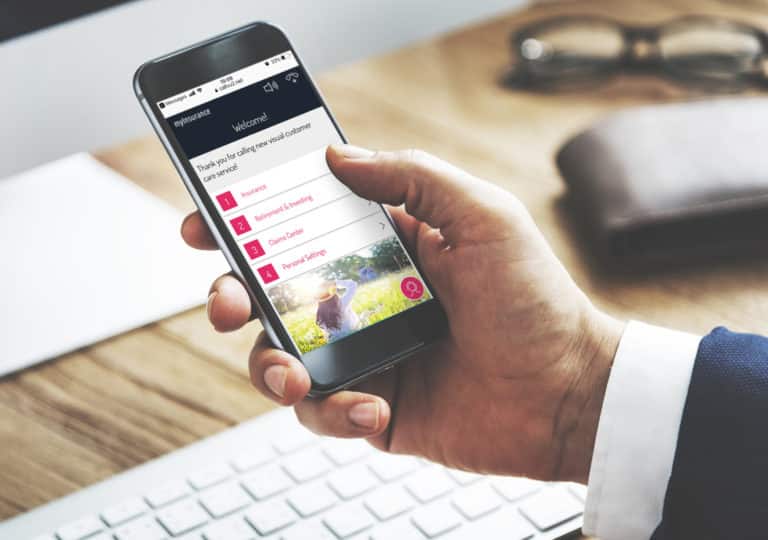What use cases work best for visual IVR? At FICX, we believe that the best way to define priorities for visual IVR development is by analyzing your contact center data. Most contact centers log every call, classifying each request into a topic area. You can pinpoint the most common challenges by reviewing this data.
Starting with the most common customer issues makes sense because if you divert a significant share of these “everyday” use cases to self-service, you can make a big dent in CSAT challenges and support costs. While not all use cases are conducive to digital self-service, you may be surprised how many are. Customer experience leaders quickly recognize that the most common customer issues are often straightforward tasks that don’t require agent intervention.
Reviewing your data is always a practical first step to defining priorities for visual IVR use cases. Additionally, understanding the common use cases for your specific industry can be valuable as you develop your Visual IVR development plan.
Banking
Balance Inquiries: Perhaps no use case screams for Visual IVR more than this one. All the customer needs to do is verify their identity, and they can access the data via self-service.
Loan Applications: Loan applications are a great use case for Visual IVR because would-be customers can begin the process of applying immediately instead of waiting for a sales rep. They can also gather necessary documents at their own pace without having a seller or support person waiting for prospects to provide all the essential details.
Credit Card Applications: Credit card applications are also a great use case for Visual IVR because they are relatively straightforward to complete. They can also be completed after regular business hours when people have more time for such activities. Companies can also save a great deal of money because no data entry/transcription is required when the customer fills out an application independently.
Book an Appointment: Scheduling appointments is far easier for the customer and the bank when users can see available slots and book the most convenient time on their own using a visual “calendar-style” interface.
Customer Onboarding: Most companies have onboarding processes that can be completed without agent assistance. This visual IVR use case makes the process more convenient and increases efficiency by intercepting more new customers before they reach a live agent.
Make a Payment: A surprising number of people reach out to call centers to make payments, even though the process is usually quite simple in a full-featured mobile app or customer portal. Visual IVR enables the customer to complete the task quickly and without waiting for a live agent. It also enhances security because the customer does not need to reveal their payment details to agents who may be in relatively insecure “work from home” settings.
Transfer Funds Between Accounts: Another relatively simple task that can be completed efficiently without assistance. As with Make a Payment, self-service makes the action safer and more secure.
Update Profile Information: Address changes, adding new users, vacation notices, and other similar information are great for Visual IVR and digital self-service.
Insurance
Get a Quote: Many insurance websites already have an automated quoting process on their websites. But our insurance clients report that thousands of customers contact their inbound sales teams and agents monthly to conduct the process. Visual IVR enables them to intercept many of those calls so that companies can gather some of the details before sellers get involved. Some companies automate all steps of the quoting process. Others use Visual IVR for initial information gathering, enabling the company and its agents to prioritize opportunities based on potential revenue.
Insurance Applications: Similar to “Get a Quote” requests, using Visual IVR to speed the insurance application process for customers has many benefits. Customers who prefer self-service to a sales pitch can complete the steps alone. Collecting some of the information required as a first step in the application process can empower sales teams to triage opportunities.
Customer Onboarding: Setting up an account or policy details can often be accomplished without agent assistance. Visual IVR can reduce your support costs, speed the new customer to completion, and reduce overall servicing costs.
Coverage Changes: Customers can complete many coverage changes on their own. Adding new cars to auto insurance coverage is a prime example. Even if your company already has a self-service process on your website or app, expanding this capability to Visual IVR with a simple, purpose-built micro-app can drive more adoption and prevent unnecessary customer support calls.
Bundle Purchases: Visual IVR is a great way to display alternative options visually, so users can compare alternatives and make the best selection. Since most people are more adept at understanding visual information, self-service apps delivered via Visual IVR are a great way to help customers quickly make the best decision.
Book an Appointment: Self-service calendaring can save sellers and support agents a great deal of time weekly. Instead of spending time in low-value scheduling conversations, they can focus more on their core value-add support responsibilities.
First Notice of Loss (FNOL): An increasingly popular option for insurance providers, FNOL apps empower customers to begin the claim process with minimum friction. Robust Visual IVR applications collect statements, images, contact information of others involved in the claim, gather e-signatures, and other necessary components of a claim. Customers that prefer self-service get a great experience, and agent time isn’t wasted as customers gather documents, etc. Many companies also leverage Visual IVR platforms to automate some of the internal process steps required for processing. This reduces company costs, drives faster resolution, and makes customers more satisfied.
Claims Status Updates: Many insurance providers report that agents and adjustors spend much time informing customers about claim status. By giving customers automated processes for checking status via Visual IVR, you improve experience and efficiency.
Provider Lists: Many insurance types, including auto, health, and workers comp, rely on distributing approved provider lists to facilitate customer compliance. A Visual IVR app can instantly deliver a list of approved providers based on a customer-input zip code.
Check Account Balance: A straightforward use case that gives customers the answer they want without waiting for a live agent.
Make a Payment: Most customers will happily comply with a digital process for making a payment if you make it “dead simple.”
Update Profile Information: Simple updates to account information are easy to manage via Visual IVR and digital self-service apps.
Healthcare
Patient Profiles: Hundreds of thousands of medical offices still use paper to collect comprehensive customer health profiles. Many others use expensive tablet-based systems that pose an infection risk if not disinfected after each use. Collecting patient information in Visual IVR means patients can arrive at medical offices with all this work completed.
Release Form Signatures: Collecting signatures digitally is preferable to emailing documents and waiting for their return. It can also be helpful to use these processes DURING live agent interactions to collect signatures immediately while the call is connected. Timelines shrink, and compliance rates spike.
Approved Provider Lists: Recommended providers, labs, and other medical service providers can be shared with patients via Visual IVR.
Book an Appointment: Scheduling is one of the most time-consuming processes for administrative staff. An appointment booking system delivered via Visual IVR can deflect these lengthy, costly, and morale-draining calls for your team.
Test Results: Most healthcare companies and providers now use full-featured mobile apps, but many customers find them challenging. They tend to be complex, and many leverage outdated design and navigation principles. Visual IVR can intercept callers to providers, medical groups, and hospitals, sparing administrative staff. Digital self-service can also help ensure customers only receive verified information.
Check a Bill/Payment Due: Get paid faster by giving customers easy access to this critical information.
Make a Payment: Credit card and PayPal payments are easy to manage in self-service applications, and leveraging them in Visual IVR prevents many calls to your administrative staff that can focus more on delivering outstanding customer care.
Telecom
Customer Onboarding: You can deflect onboarding calls with well-designed processes offered via Visual IVR. Great digital self-service experiences condition customers to seek self-service versus placing calls or visiting retail locations.
Transfer of Account Ownership: Many customers may need to transfer account ownership or add users. This task is EASIER for most people to complete via Visual IVR than in a live agent conversation. Across FICX clients, for example, customers show higher rates of satisfaction when they use these digital processes versus waiting to speak with an agent.
Service Level Changes: As in other industries, customers make better choices when presented with alternatives visually in a Visual IVR experience.
Check Balance: This is a widespread use case, especially for PAYG providers and programs. Managing this task visually in a Visual IVR application saves time and money.
Make a Payment: Customers resolve their needs more quickly with Visual IVR and enjoy increased security versus sharing their credit card information with live agents.
Other industries
There are so many industries that it is impossible to identify a comprehensive list of what tasks could be addressed with Visual IVR and digital self-service experiences. But here are some examples to spur your thinking.
Customer Onboarding: If your business has a relatively straightforward new customer process, it can probably be delivered in Visual IVR.
Service Level Changes: As with our example industries above, many businesses can prevent unnecessary live agent conversations and make choices more efficiently by providing visual comparisons in self-service apps.
Check Balance: Often the most common request for call centers, Visual IVR can deflect many calls and get customers the information they want more quickly.
Make a Payment: It is generally easier to provide payment information online than via a call to a contact center.
Implementing Visual IVR Priorities For Your Business
You have options for Visual IVR deployment. As we mentioned at the beginning of this post, focusing on common customer questions and tasks enables you to impact the greatest number of interactions. But there are other considerations you should make before finalizing your plan. For more insights, check out our homepage, request a demo, or explore the other Visual IVR content available below.





